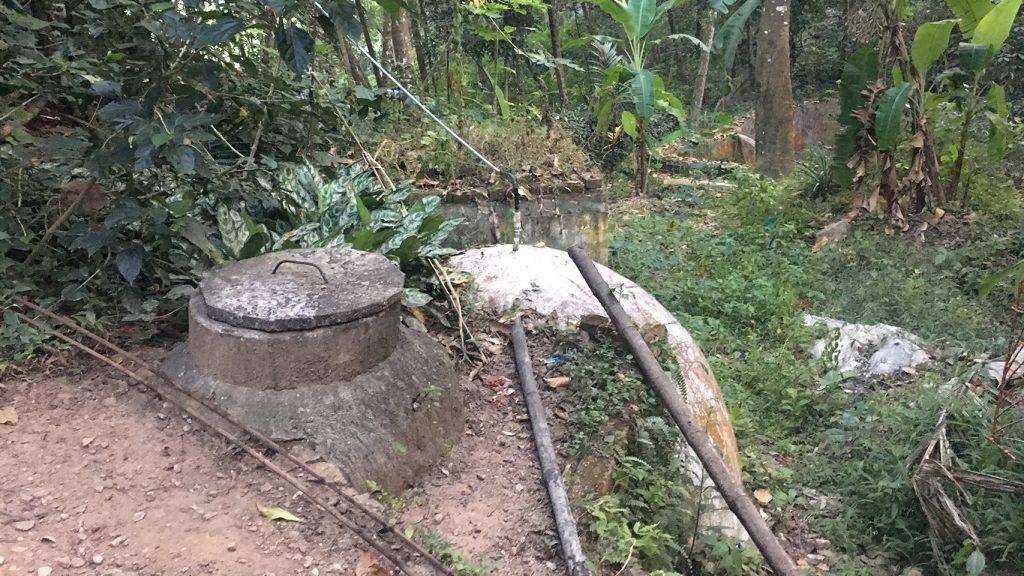Weisbrod: Turning food waste into energy — it’s not science fiction.
There’s a way to turn food waste into free energy, and we should be doing more with it.
A biodigester collects food and human waste from the Laurie Baker Centre in Trivandrum, India, on Dec. 30, 2017. Inside the concrete mechanism, organic waste decomposes anerobically to produce methane, a gas burned as fuel in the center’s kitchen.
March 22, 2018
Coming back from studying abroad is weird. Everyone wants to know about the food. They want to see my photos. They want to know about the flight and if I adjusted well and if I got sick.
Mostly they want to know the best part.
“What was your favorite thing?”
At first, I would come up blank.
It wasn’t that I couldn’t think of a singular thing that I will fondly remember as my favorite. It’s that my answer wasn’t really what my friends and family were looking for.
“Probably the biodigester.”
I can imagine the looks I would get after I explain the biodigester is a concrete dome with a lid where food and human waste goes to decompose anaerobically and produce methane, which is used as cooking fuel.
I was perplexed when my professor, Jerry Anthony, explained this. I had never seen such a thing. What an amazing way to deal with organic waste. It’s simple, low maintenance, inexpensive, and it produces fuel. Why don’t these exist at the University of Iowa? Or in local restaurants? Or in sorority houses or apartment buildings or event centers?
It turns out the Centre of Science and Technology for Rural Development (COSTFORD), the architecture firm that had constructed the biodigester had many others around Trivandrum, the south Indian city where I studied.
P.B. Sajan, the joint director of COSTFORD, persuades all his clients to install biodigesters on their properties. About a quarter of his clients opt out of using it in the septic tank, though.
“We suggest, and they go ‘egh,’ ” Sajan said. “They will use the biodigester, but they will not connect it to the toilets.”
But that’s OK, because food waste is a big enough problem in the U.S. In 2014, more than 20 percent of landfill waste was food, the Environmental Protection Agency reported. Composting is great, but I tried doing that for a while, and it’s really disgusting. It’s definitely hard to get non-eco-geeks on board with that.
With the biodigester, you literally throw your banana peels, coffee grounds, and moldy bread inside, and you never have to smell it again. Then it starts producing methane. Then you have free energy. Then you save money on your electricity bill. Genius.
Methane is a greenhouse gas at least 25 times more powerful than carbon dioxide, according to the EPA. When methane burns, it is converted into carbon dioxide. If we do not collect this methane and burn it, it will radiate into the atmosphere and contribute to the greenhouse effect 25 times more powerfully than carbon dioxide would.
Simply put, methane is a lot better at heating up our planet than the coal-burning byproduct that serves as the typical culprit behind climate change. By harnessing the methane in a biodigester and burning it as fuel, we can reduce the impact of the greenhouse effect and fight impending climate change.
The thing is, biodigesters aren’t new. There are 2,100 operational biogas sites in the U.S., according to the American Biogas Council, and the potential for more is enormous.
A household-scale, simple biodigester in a cold climate would cost about $250, the Innovation for Development and South-South Cooperation claims. The university would likely need something more sophisticated and larger scale, but the device should not be wildly expensive.
Of course there’s a catch. I knew it was too good to be true. Anthony, a UI associate professor of urban and regional planning, said biodigesters may not work so well in the Midwest. The bacteria that decompose the organic waste need a warm climate to function. Step outside from October to March — we don’t have that here.
Anthony has a solution though. If you go below the frost line, about 6 feet deep, the earth is relatively warm. Just put a hole for the waste to go in, and a pipe for the gas to go out. Voilà.
The UI actually already composts the waste produced in the dining halls with food pulpers in Burge and Hillcrest. But we could hook a biodigester up to the toilets, too.
Sajan said it’s much more ideal to include human waste in the biodigester. It introduces the bacteria necessary to keep the digestion going, otherwise the system may require an expensive bacteria supplement.
So that was my favorite thing, and it could make a real difference in our collective waste disposal. We need to ask our city, our university, our landlords, and local businesses if they are doing enough to keep food waste out of the landfills.
We may not realize it, but students are the ones who have the power to make a change.
“A lot of the initiatives that are happening at the university are not because the university is leading them, it’s because students are pushing them,” Anthony said. “Almost everything in sustainability has been done in response to the student pressure, not because the university was enlightened.”



